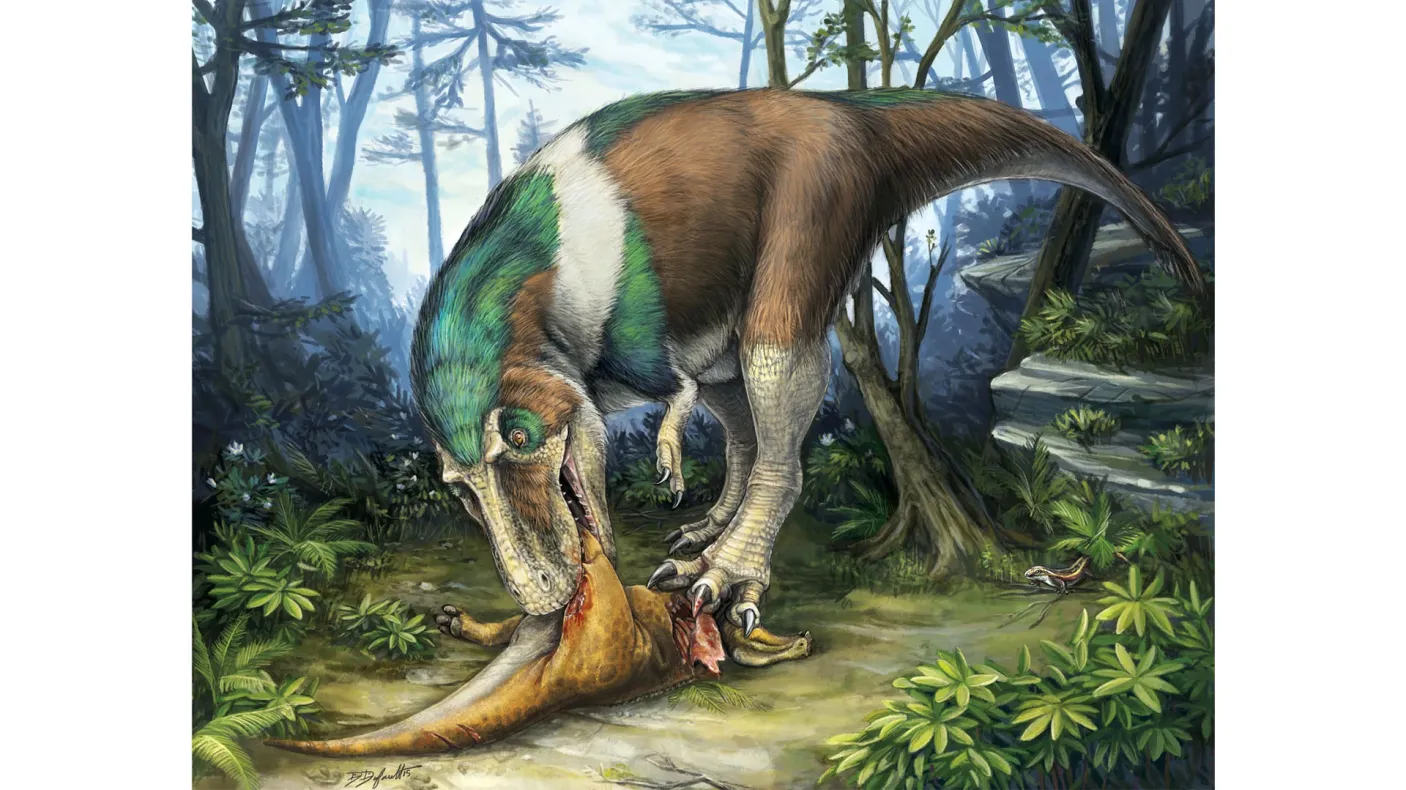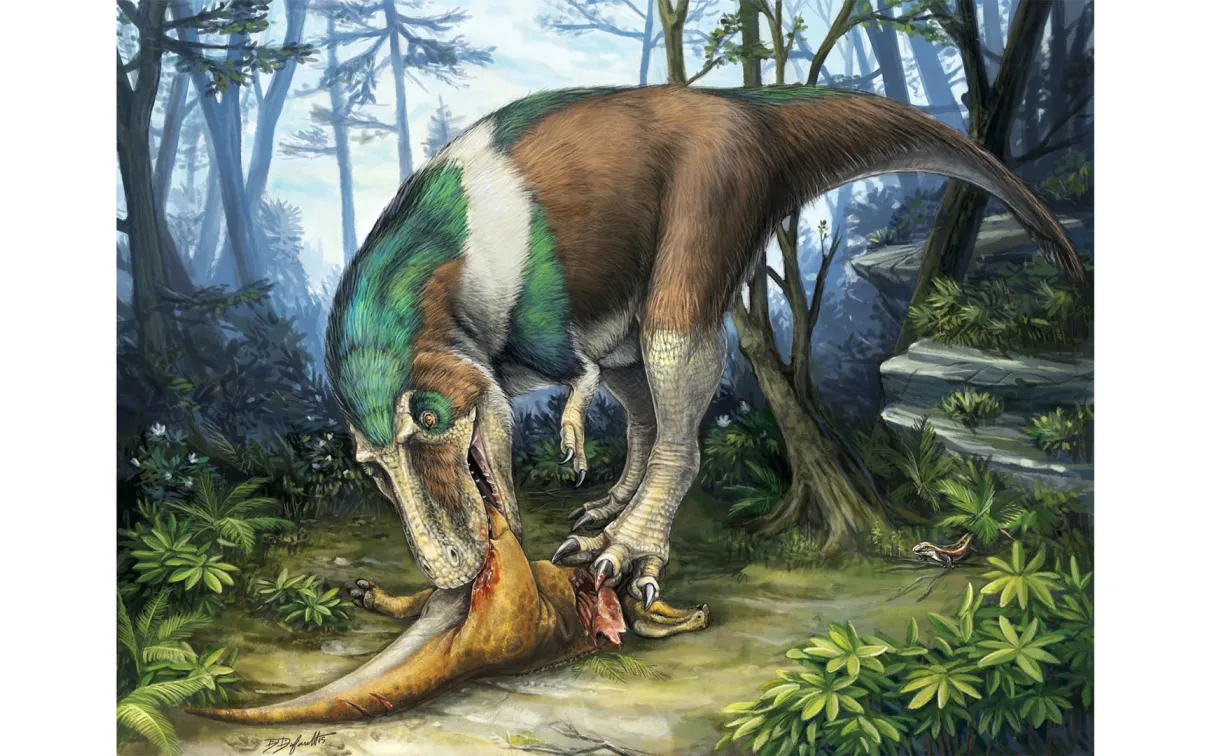Ask an Expert
From the lack of genitals on museum models to whether it felt sadness and other emotions, palaeontologist Gregory Funston answers questions about how the Tyrannosaurus rex lived and evolved.
Published
Category
Author
This summer we issued a call to ROM Members
This summer we issued a call to ROM Members asking them to send us questions they had about how T. rex lived and evolved in connection to the T. rex: The Ultimate Predator exhibition. We received so many excellent responses that we couldn’t possibly answer them all! Many of you had the same or similar questions, so we’ve chosen your most popular questions here.
Why were the T. rex’s arms so short and seemingly useless?
This is the quintessential question about T. rex and its relatives, and it has perplexed palaeontologists ever since T. rex was first named (in 1905, as some ROM Members asked). Now, we think we may finally have an answer. I have been leading a project with other experts in tyrannosaurs and biomechanics, and we have traced the evolution of the arm back across the tyrannosaur family tree. Using some advanced statistics and computer simulations, we found that tyrannosaur arms actually became shorter at the same time as they developed some of their other key adaptations.
Surprisingly, this happened before tyrannosaurs achieved their gargantuan body sizes; many palaeontologists had drawn links between the short arms and their big bodies and heads. Shortening of the arms accompanied changes in the arrangement and size of the muscles that would have made the arms better for pulling back—useful if you were latched on to prey or a potential mate. Shorter arms increase the strength of this motion, so a change in how the arms were used might have been a driving force in making them shorter. Altogether, this tells us that the short arms of T. rex, rather than being a limitation, were something that gave it some sort of advantage in life, probably when it was a youngster and it needed to grapple with prey.
What was T. rex’s childhood like?
T. rex’s childhood is one of the most mysterious parts of its life: there are very few fossils of baby tyrannosaurs. However, in 2021 I led a team that presented the first embryonic tyrannosaur fossils—a jaw and a claw so small that they would still have been within the egg. T. rex probably laid eggs, but whether they were hard-shelled (like most other dinosaurs), or soft-shelled like dinosaur ancestors, is still unclear because we have not found any tyrannosaurid egg fossils.
We also do not know how long a baby incubated, although we know how we could tell: as they grow, teeth lay down daily growth lines, and by looking inside the teeth of the embryonic jaw, we could estimate how long it was in the egg. However, this process destroys part of the fossil, so we are hesitant to try it. When it hatched, a baby tyrannosaur would have been about 1 metre long and would have looked similar to an adult, but with much longer legs and a shorter face. Based on how well-formed the bones of the embryo are, we think that it was probably active and fairly self-sufficient when it hatched. This means it probably would not need much care from its parents, but most tyrannosaur fossils we find are more than four to five years old, so many of the young survived anyways.
How did T. rex hunt and what did it eat?
T. rex’s pointed, bone-crushing teeth tell us it was a meat-eater. Some palaeontologists once thought it might have been a scavenger, but we know for certain now that T. rex hunted Edmontosaurus and Triceratops from survivors of attacks with teeth still embedded in their bones. We also know from stomach contents that earlier relatives of T. rex hunted smaller game, too, like toothless oviraptorosaurs and ornithomimids. Some of these species, like Albertosaurus and Daspletosaurus, probably lived in groups together, but whether they hunted in packs is uncertain. Analyses of running speed tell us that T. rex was probably an ambush predator rather than a pursuit predator, because it was agile but slow. Once it caught its prey, one powerful bite is all it would need to subdue it and begin the feast.
How massive was T. rex? — Ethan
It was the biggest of the big. The two most common ways to measure an animal are the length from snout to tail, and the weight. T. rex wasn’t the longest dinosaur (that title goes to the giant sauropods), or even the longest meat-eating dinosaur (Spinosaurus probably got longer). But, it was the heaviest carnivore that has ever roamed dry land, with the biggest specimen known weighing some 9 metric tons (20,000 lbs). That’s about the weight of about three heavy-duty pickup trucks. Some palaeontologists think that it could have gotten even bigger. Based on size ranges in living animals like crocodiles and people, scientists speculated at a conference in 2021 that the largest T. rex to ever roam the planet would have been 70 percent larger, more than the weight of a school bus.
A weird question (maybe) but it occurred to me while touring the exhibition that the dino's private parts are never included in models. Do palaeontologists know what T. rex genitalia looked like or is the absence of them in exhibits simply Victorian modesty? Curious! — Anonymous
While questions about T. rex’s reproductive organs may seem silly on the surface, reproduction is an important part of any animal’s life. We know about T. rex genitalia from its living dinosaur relatives: birds. Birds do not have externally visible genitalia, and instead they have a reproductive apparatus called a cloaca. The cloaca is a multi-purpose hole that is used for reproduction, urination, and defecation. (Bird poop has both urinary and fecal matter within it—that is why it is runny!) Most birds reproduce using what is called a “cloacal kiss,” where the cloacae are pressed together briefly and sperm is exchanged. Some birds, and crocodiles, also have an external phallus (a penis) hidden within the cloaca, but this is only visible when in use. We know from some exceptional fossils of Psittacosaurus preserving soft tissue that dinosaurs also had cloacae, but we do not know yet whether any dinosaur species also had a phallus. So dinosaur depictions are not just modest, they are accurate too!
Did T. rex feel sadness and other emotions? — Alisa
It is important to think of dinosaurs as animals, rather than terrifying monsters or mindless killers—they would have been much more like animals today than many people realize. We cannot observe the range of emotions dinosaurs experienced, but we can look at their brain to understand their senses and their degree of sentience. In general, the bigger an animal’s brain compared to its body weight, the smarter and more sentient it is. We can reconstruct dinosaur brains by looking at the space in the skull that the brain occupied, which shows that some dinosaurs, like Troodon, had enormous brains comparable to modern birds, which certainly feel a range of emotions. Some palaeontologists even think it is likely that Troodon could have used basic tools, like crocodiles and birds today. Tyrannosaurs had brain ratios similar to ostriches, chickens, pigeons, and flamingoes. Although not the brightest of birds, chickens have an incredible range of emotions, are empathetic to others, and can even use a degree of logic similar to a seven-year-old human! So T. rex might have been capable of similar intellectual achievements.
Did T. rex get diseases such as cancer? — Owen W.B.
Cancer is a terrible disease that affects millions of Canadians, and so we often think of it as a human-specific issue. However, cancer is prevalent throughout the animal kingdom, and it is even known in the fossil record: 300-million-year-old fish, a 240-million-year-old turtle, and recently, a 76-million-year-old relative of Triceratops called Centrosaurus, a discovery by researchers at the ROM and McMaster University. This horned dinosaur had a form of bone cancer that caused the bone to grow a large mass of extra tissue, which was fossilized. Similar lumps are known in other meat-eating dinosaurs, but their exact causes have not been diagnosed. So although we have not found firm evidence of cancer in T. rex yet, we know other dinosaurs were affected by this disease, and so it is likely that T. rex was, too.
How do scientists determine what sounds T. rex may have made? — Elara
One of my favourite interactives at T. rex: The Ultimate Predator is the T. rex roar station, where you can create your own sound for the tyrant lizard king. T. rex could not roar like a lion or tiger—that ability comes from a special piece of cartilage in the throat of cats—but it is likely that T. rex could make some kind of deep rumbling sound. Its close relatives today, birds and crocodiles, each make loud bellowing sounds. A crocodile bellow sounds like a terrifying, rolling burp, and some bird species like the Cassowary and various grouse can make deep wump-wump sounds, too. We can look at the shapes of the internal ear structures of dinosaurs to tell what sounds they could hear, a good indication of sounds they made. A recent study found that they had good sensitivity to low-pitched sounds, but that they also evolved sensitivity to high-pitched sounds. This probably helped them communicate with their squeaky young, and some smaller dinosaur species may even have chirped. A T. rex may have made a variety of sounds through its lifetime, but if its living bird relatives are any indication, it was unlikely to be silent.
What do I need to take in high school and university to be able to find a T. rex? I want to be a palaeontologist! — Emma D.
It is really important to know that anyone can become a palaeontologist! Palaeontology uses includes tools and insights from many disciplines, and every background is helpful, whether that is biology, programming, drawing, hiking, craft-making, or anything else. Palaeontologists who want to do original research usually go to university for a degree in biology or geology, so related courses can be useful to take in high school. In high school, I took biology and chemistry, and then I went to university for a four-year degree in palaeontology, combining biology and geology, followed by a six-year PhD program. A career advisor at school may be able to help you identify universities with programs in evolutionary biology or geology, and what courses you need to take for admission. But you don’t have to be an academic to be a palaeontologist. Fossil preparators and field technicians, who go out to find, excavate, and clean dinosaurs, don’t always have an academic background. Neither do museum science communicators, or palaeoartists, who do the important work of representing research for public audiences. The most important thing is your passion for fossils!
Dr. Greg Funston
Dr. Greg Funston is a Banting Postdoctoral Fellow at ROM. His research focuses on the growth of extinct dinosaurs and mammals, and how ecosystems evolved over millions of years. His work has taken him around the world, from the badlands of Alberta, to the Gobi Desert of Mongolia. Follow his research on Instagram and Twitter @funstonpaleo.


